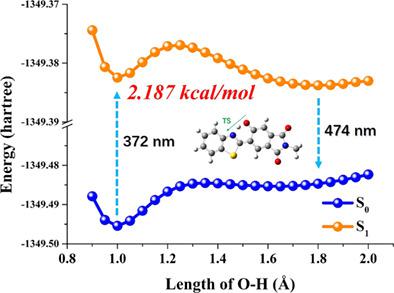当前位置:
X-MOL 学术
›
J. Chin. Chem. Soc.
›
论文详情
Our official English website, www.x-mol.net, welcomes your
feedback! (Note: you will need to create a separate account there.)
Photo‐excited intramolecular charge transfer and excited state intramolecular proton transfer behaviors for HPIBT system: A theoretical investigation
Journal of the Chinese Chemical Society ( IF 1.6 ) Pub Date : 2020-06-01 , DOI: 10.1002/jccs.202000121 Guang Yang 1 , Kaifeng Chen 1 , Xiaofeng Jin 1 , Dapeng Yang 2
Journal of the Chinese Chemical Society ( IF 1.6 ) Pub Date : 2020-06-01 , DOI: 10.1002/jccs.202000121 Guang Yang 1 , Kaifeng Chen 1 , Xiaofeng Jin 1 , Dapeng Yang 2
Affiliation

|
Given facile synthetic route and excellent photo stability, excited state intramolecular proton transfer (ESIPT)‐active luminous materials have gained more and more attention. Here, we focus on photo‐induced excitation process and the ESIPT reaction process for the novel 5‐benzothiazol‐2‐yl‐6‐hydroxy‐2‐methyl‐isoindole‐1,3‐dione (HPIBT) molecule. On the level of chemical geometries and infrared spectra, we verify that O─H⋯N of HPIBT should be enhanced. We find that a proton is likely to be attracted by enhanced electronic densities around N, that is, charge transfer impetus ESIPT trend. Combing potential energy curves and searching for transition state, we clarify the ultrafast ESIPT mechanism of HPIBT due to a low barrier, which legitimately explains previous experimental characteristics.
中文翻译:

HPIBT系统的光激发分子内电荷转移和激发态分子内质子转移行为:理论研究
鉴于简便的合成途径和出色的光稳定性,激发态分子内质子转移(ESIPT)活性发光材料越来越受到关注。在这里,我们专注于新型5-苯并噻唑-2-基-6-6羟基-2-甲基异吲哚-1,3-二酮(HPIBT)分子的光诱导激发过程和ESIPT反应过程。在化学几何形状和红外光谱的水平上,我们验证了HPIBT的O─H⋯N应该增强。我们发现质子可能被N附近增强的电子密度所吸引,也就是说,电荷转移推动了ESIPT趋势。结合势能曲线并寻找过渡态,我们阐明了由于势垒低而导致的HPIBT超快ESIPT机制,这可以合理地解释先前的实验特性。
更新日期:2020-06-01
中文翻译:

HPIBT系统的光激发分子内电荷转移和激发态分子内质子转移行为:理论研究
鉴于简便的合成途径和出色的光稳定性,激发态分子内质子转移(ESIPT)活性发光材料越来越受到关注。在这里,我们专注于新型5-苯并噻唑-2-基-6-6羟基-2-甲基异吲哚-1,3-二酮(HPIBT)分子的光诱导激发过程和ESIPT反应过程。在化学几何形状和红外光谱的水平上,我们验证了HPIBT的O─H⋯N应该增强。我们发现质子可能被N附近增强的电子密度所吸引,也就是说,电荷转移推动了ESIPT趋势。结合势能曲线并寻找过渡态,我们阐明了由于势垒低而导致的HPIBT超快ESIPT机制,这可以合理地解释先前的实验特性。











































 京公网安备 11010802027423号
京公网安备 11010802027423号